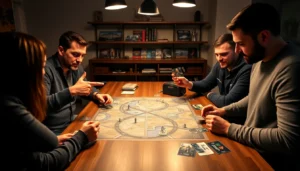Table of Contents
ToggleIn a world where jump scares reign supreme and creepy soundtracks send shivers down spines, classic horror games hold a special place in the hearts of gamers. These pixelated nightmares not only challenge players to survive but also take them on a spine-tingling journey through dark corridors and haunted landscapes. Who wouldn’t want to trade their cozy couch for a heart-pounding adventure filled with ghouls and ghosts?
Overview of Classic Horror Games
Classic horror games encompass a unique genre that captivates players through chilling storytelling and atmospheric tension. These games often immerse players in unsettling worlds, featuring haunting soundtracks and eerie visuals. Notable titles, including “Resident Evil,” “Silent Hill,” and “Alone in the Dark,” set the bar for horror gaming, blending narrative depth with challenging gameplay.
Graphic styles vary across titles, with pixel art evoking nostalgia, while early 3D graphics create a sense of immersion. Engaging puzzles often challenge players to solve mysteries, adding layers to the gameplay experience. The psychological elements in classics like “Silent Hill” provoke fear not just through monsters, but through themes of loneliness and despair.
Survival mechanics play a crucial role in these games, often forcing players to manage limited resources like health and ammunition. Tension builds as they navigate dimly lit environments, encountering jump scares and relentless adversaries. Developers leverage the fear of the unknown, ensuring that every corner holds potential danger.
Players often find themselves emotionally invested in the characters’ journeys, facing moral dilemmas and life-or-death situations. Sound design, including unsettling noises and sudden auditory cues, heightens the atmosphere and enhances the overall gaming experience.
Classic horror games resonate with those who appreciate a blend of adrenaline and storytelling. The players’ shared experiences, like facing their fears or uncovering shocking truths, fuel discussions within gaming communities. This rich legacy of horror gaming continues to inspire modern titles, proving that the thrill of fear remains timeless.
Notable Classic Horror Games
Classic horror games have left an indelible mark on the gaming landscape. Players often reminisce about their memorable experiences with these titles.
Resident Evil
Resident Evil revolutionized the survival horror genre upon its release in 1996. Players navigate the terrifying environments of the Spencer Mansion, facing off against zombies and bizarre creatures. Resource management is critical, as ammunition and health items are scarce. Intricate puzzles challenge the mind and enhance the overall experience. Iconic characters like Chris Redfield and Jill Valentine contribute to the gripping narrative. With its atmospheric graphics and haunting soundtrack, Resident Evil sets a high standard for psychological tension and fear.
Silent Hill
Silent Hill debuted in 1999, captivating players with its psychological horror approach. The game’s narrative delves deep into themes of guilt and psychological trauma, creating a surreal experience. Players step into the shoes of Harry Mason as he searches for his missing adopted daughter. Eerie fog envelops the town, heightening the sense of dread. As players explore, they encounter monstrous manifestations of their fears. The chilling sound design amplifies the haunting atmosphere, making every encounter unsettling and impactful.
Alone in the Dark
Alone in the Dark premiered in 1992, often credited as the first 3D survival horror game. Set in a haunted estate, players control private investigator Edward Carnby. Solving intricate puzzles and battling supernatural foes creates a nerve-wracking experience. Unique for its combination of exploration and combat, the game encourages players to interact with the environment while managing inventory. Classic elements like fixed camera angles enhance the suspense. Alone in the Dark laid groundwork for future horror titles, establishing crucial gameplay mechanics and storytelling techniques.
Key Features of Classic Horror Games
Classic horror games stand out due to their immersive elements, engaging players through various techniques that enhance fear and suspense.
Atmosphere and Setting
Eerie environments profoundly affect player experience. Designers utilize dim lighting, unsettling soundscapes, and meticulously crafted visuals to create tension. Spaces often feel claustrophobic, making players anxious as they explore. Fog and shadows obscure visibility, heightening fear of the unseen. Classic horror games leverage these elements to envelop players in a foreboding atmosphere, transporting them to nightmarish realms.
Storytelling Techniques
Narrative depth plays a crucial role in classic horror. These games often intertwine character backstories with haunting themes, allowing players to connect emotionally. They tackle complex emotions like guilt and trauma, making players reflect on their own experiences. Flashbacks or fragmented storytelling enhance immersion, guiding players through psychological journeys filled with tension. Engaging narratives ensure investment in character fates, raising stakes as players confront fears.
Gameplay Mechanics
Innovative gameplay mechanics change how players interact with horror. Resource management becomes vital, forcing strategic decisions under pressure. Limited ammunition or health prompts players to evade rather than confront enemies. Various puzzles challenge critical thinking while progressing the story. Jump scares inject adrenaline, keeping players on edge. These core mechanics create a rich gameplay experience that elevates horror narratives, making engagements unforgettable.
The Impact of Classic Horror Games
Classic horror games influence both developers and players today. They set foundational elements that modern horror titles incorporate, blending atmosphere, tension, and psychological depth.
Influence on Modern Horror Games
Modern horror games often draw inspiration from the mechanics and narratives established in classic titles. Examples include resource management from “Resident Evil” and psychological storytelling akin to “Silent Hill.” Developers frequently revisit themes of fear and survival, ensuring these elements resonate with new audiences. Innovations, such as immersive environments and narrative-driven gameplay, maintain the engaging aspects that classic games pioneered. Drawing upon these games’ successes allows contemporary creators to refine their storytelling techniques, ensuring horror continues to evolve while paying homage to its roots.
Cultural Significance
Classic horror games hold a substantial place in gaming history and popular culture. They introduced scare tactics that influenced films, literature, and other media forms, fostering deeper discussions about fear and human psyche. Iconic titles became benchmarks for quality and innovation, shaping industry standards. Communities formed around these games, facilitated by shared experiences and nostalgia, highlighting their role in fostering social connections. As these titles continue to inspire both creators and players alike, they remain integral to cultural narratives about horror and storytelling.
Classic horror games continue to captivate audiences with their unique blend of suspense and immersive storytelling. They’ve created unforgettable experiences that resonate with players long after the game ends. The combination of chilling atmospheres and engaging gameplay mechanics keeps fans returning for more, eager to face their fears.
These games have not only shaped the horror genre but have also influenced countless modern titles. Their legacy lives on through the emotional connections players forge with characters and narratives. As new generations discover these classics, the thrill of fear remains an enduring aspect of gaming culture.




